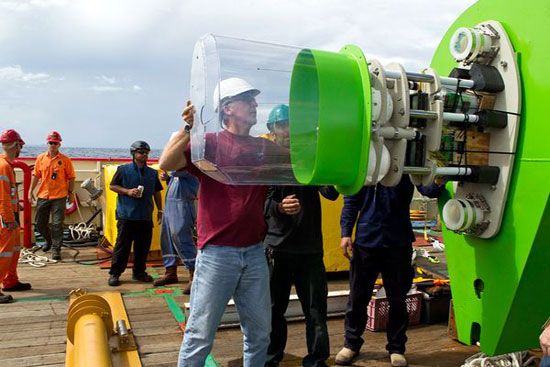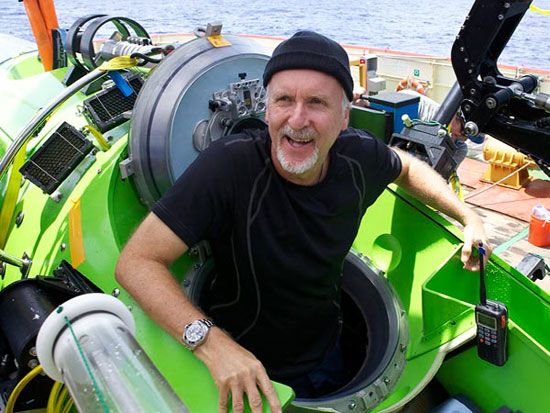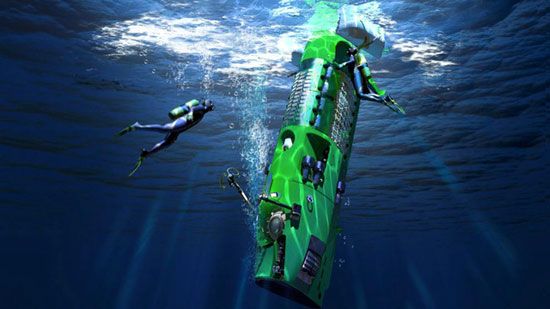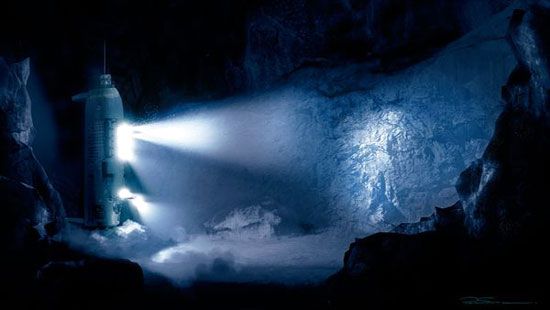
Brook Rushton / Deepsea Challenge
Props to filmmaker James Cameron for successfully diving to the deepest part of the Pacific Ocean, and to be more exact, the deepest point on Earth. At 7 PM, Pacific Daylight Time yesterday, Cameron's Deepsea Challenger submersible was lowered into the water 200 miles off the coast of Guam. After a 2 1/2-hour descent, Cameron safely landed on the surface of the Mariana Trench's Challenger Deep, which has a depth ranging from 35,768 feet (10,902 meters) to 35,814 feet (10,916 meters). Cameron spent about 3 hours exploring the "lunar-like" landscape (Cameron's own words)...taking some soil samples (even though the sub's robotic arm wasn't operable because of a hydraulics leak) and filming the outside environment (in 3-D) before returning back to the surface in a 70-minute ascent. Not surprisingly, Cameron is planning to go back to this vast, undersea frontier in the future.

Mark Thiessen / National Geographic
I think it's totally awesome that Cameron would go on such endeavors when he's not making blockbuster movies such as Avatar and Titanic (whose actual wreckage he visited in the Atlantic multiple times). It's not much of a presumption to say that his experience at Challenger Deep will no doubt influence Cameron's vision for Avatar 2 for when he begins pre-production on it a few years from now...especially considering the fact that Avatar 2 is supposedly set to take place underwater.

James Cameron was also involved with the MastCam (Mast Camera) instrument on NASA's Mars-bound Curiosity rover. Originally, the MastCam, which are the two main cameras aboard the rover, was suppose to have zoom-in lens that would've allowed Curiosity to shoot movie-quality videos and 3-D images of the Red Planet's landscape...videos and images that Cameron would've no doubt combined into an actual film to mesmerize the public with. Unfortunately, due to budget issues, NASA shelved the zoom-in lens...with Curiosity having static ones installed instead.

NASA / Charisse Nahser
One wonders what kind of amazing film James Cameron would've made if he had real 3-D pictures of Mars at his disposal. No doubt the imagery would be as amazing as anything we see in Avatar or from NASA's other deep space missions. I also seem to recall that he wanted to visit the International Space Station once...being a 'space tourist' whose achievement would've no doubt resonated in Hollywood and space aficionado groups alike. To get back to what has actually been achieved, we can be thankful that Cameron is sharing his journey (and future trips) into a 7-mile-deep watery abyss with the rest of us. As the saying goes, the ocean really is the last unexplored frontier.

Acheron Project Pty. Ltd.

No comments:
Post a Comment